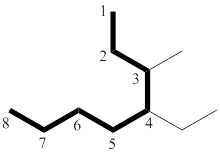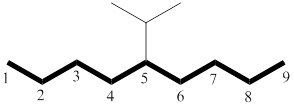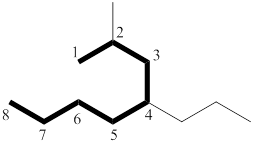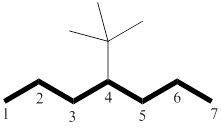
(a)
Interpretation:
The name of the Parent chain for the given compound should be identified.
Concept introduction:
Parent chain is the longest chain of a compound. If there are two longest chains, the more substituted chain is the parent chain.
Name for the
| Number of carbon atoms | Name of parent alkane |
| 1 | methane |
| 2 | ethane |
| 3 | propane |
| 4 | butane |
| 5 | Pentane |
| 6 | hexane |
| 7 | Heptane |
| 8 | octane |
| 9 | nonane |
| 10 | decane |
(a)
Answer to Problem 36PP
Octane
Explanation of Solution
The longest chain of the given compounds is identified by counting the number of carbon atoms presented in each chain of a compound. Longest chain is the carbon skeleton of a molecule that contains more number of carbons.

The longest chain has eight carbon atoms. By referring the above table, deduce the name as octane for parent chain.
(b)
Interpretation:
The name of the Parent chain for given compounds should be identified.
Concept introduction:
Parent chain is the longest chain of a compound. If there are two longest chains, the more substituted chain is the parent chain.
Name for the alkane parent chain depends on the number of carbon atoms present in the longest continuous carbon chain.
| Number of carbon atoms | Name of parent alkane |
| 1 | methane |
| 2 | ethane |
| 3 | propane |
| 4 | butane |
| 5 | Pentane |
| 6 | hexane |
| 7 | Heptane |
| 8 | octane |
| 9 | nonane |
| 10 | decane |
(b)
Answer to Problem 36PP
Nonane
Explanation of Solution
The longest chain of the given compounds is identified by counting the number of carbon atoms presented in each chain of a compound. Longest chain is the carbon skeleton of a molecule that contains more number of carbons.

The longest chain has nine carbon atoms. By referring the above table, deduce the name as nonane for parent chain.
(c)
Interpretation:
The name of the Parent chain for given compounds should be identified.
Concept introduction:
Parent chain is the longest chain of a compound. If there are two longest chains, the more substituted chain is the parent chain.
Name for the alkane parent chain depends on the number of carbon atoms present in the longest continuous carbon chain.
| Number of carbon atoms | Name of parent alkane |
| 1 | methane |
| 2 | ethane |
| 3 | propane |
| 4 | butane |
| 5 | Pentane |
| 6 | hexane |
| 7 | Heptane |
| 8 | octane |
| 9 | nonane |
| 10 | decane |
(c)
Answer to Problem 36PP
Octane
Explanation of Solution
The longest chain of the given compounds is identified by counting the number of carbon atoms presented in each chain of a compound. Longest chain is the carbon skeleton of a molecule that contains more number of carbons.

Here there are two longest chain of carbon atoms presented. But one has one substituent and other has two substituents. So the two substituted longest chain is the parent chain.
The longest chain has eight carbon atoms. By referring the above table, deduce the name as octane for parent chain.
(d)
Interpretation:
The name of the Parent chain for given compounds should be identified.
Concept introduction:
Parent chain is the longest chain of a compound. If there are two longest chains, the more substituted chain is the parent chain.
Name for the alkane parent chain depends on the number of carbon atoms present in the longest continuous carbon chain.
| Number of carbon atoms | Name of parent alkane |
| 1 | methane |
| 2 | ethane |
| 3 | propane |
| 4 | butane |
| 5 | Pentane |
| 6 | hexane |
| 7 | Heptane |
| 8 | octane |
| 9 | nonane |
| 10 | decane |
(d)
Answer to Problem 36PP
Heptane
Explanation of Solution
The longest chain of the given compounds is identified by counting the number of carbon atoms presented in each chain of a compound. Longest chain is the carbon skeleton of a molecule that contains more number of carbons.

The longest chain has seven carbon atoms. By referring the above table, deduce the name as heptane for parent chain.
Want to see more full solutions like this?
Chapter 4 Solutions
EBK ORGANIC CHEMISTRY-PRINT COMPANION (
 ChemistryChemistryISBN:9781305957404Author:Steven S. Zumdahl, Susan A. Zumdahl, Donald J. DeCostePublisher:Cengage Learning
ChemistryChemistryISBN:9781305957404Author:Steven S. Zumdahl, Susan A. Zumdahl, Donald J. DeCostePublisher:Cengage Learning ChemistryChemistryISBN:9781259911156Author:Raymond Chang Dr., Jason Overby ProfessorPublisher:McGraw-Hill Education
ChemistryChemistryISBN:9781259911156Author:Raymond Chang Dr., Jason Overby ProfessorPublisher:McGraw-Hill Education Principles of Instrumental AnalysisChemistryISBN:9781305577213Author:Douglas A. Skoog, F. James Holler, Stanley R. CrouchPublisher:Cengage Learning
Principles of Instrumental AnalysisChemistryISBN:9781305577213Author:Douglas A. Skoog, F. James Holler, Stanley R. CrouchPublisher:Cengage Learning Organic ChemistryChemistryISBN:9780078021558Author:Janice Gorzynski Smith Dr.Publisher:McGraw-Hill Education
Organic ChemistryChemistryISBN:9780078021558Author:Janice Gorzynski Smith Dr.Publisher:McGraw-Hill Education Chemistry: Principles and ReactionsChemistryISBN:9781305079373Author:William L. Masterton, Cecile N. HurleyPublisher:Cengage Learning
Chemistry: Principles and ReactionsChemistryISBN:9781305079373Author:William L. Masterton, Cecile N. HurleyPublisher:Cengage Learning Elementary Principles of Chemical Processes, Bind...ChemistryISBN:9781118431221Author:Richard M. Felder, Ronald W. Rousseau, Lisa G. BullardPublisher:WILEY
Elementary Principles of Chemical Processes, Bind...ChemistryISBN:9781118431221Author:Richard M. Felder, Ronald W. Rousseau, Lisa G. BullardPublisher:WILEY





